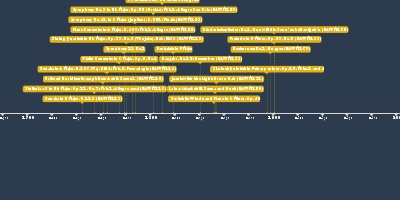1 janv. 1826 - String Quartet in C# Minor, Op. 131: Mvts. 1 and 2 (NAWM 127)
Description:
Composer: BeethovenGenre: String Quartet
The fourth of five quartets that he composed during his last three years of life, Beethoven himself thought these quartets were his greatest work in the medium.
This quartet is comprised of 7 movements played without pause, reordering and adding movements to those of a traditional sonata.
Mvt. 1 (c# minor) - fugue
Most unusual because it juxtaposes the traditional order of fast first movements and a fugal final movement. This fugue in particular stands apart with its extreme emotionalism, novel harmony, and anticipation of the main key centers of later movements.
Harmony includes augmented triads and some unusual progressions: E major, G# minor, A major, D major (all keys foreshadowed and seen in later movements). The complex key relationships within the fugue might be a sign that Beethoven intended the work to be studied and appreciated by connoisseurs.
Mvt. 2 (D major) - sonata-rondo
Refers back to the first movement, specifically to the keys of its fugue subject and answer through cadences on C# and F#, far outside the key scheme of the rest of the movement. It combines aspects of sonata and rondo form, with various elements satisfy requirements for both. The first and second movements are usual finale forms, rarely seen at a quartet's beginning.
Mvt. 3 (B minor) - recitative-like
A brief introduction to the slow movement
Mbt 4 (A major) - slow movement (in variation form)
Mvt 5 (E major) - the scherzo (in duple instead of triple meter)
Mvt 6 (g# minor) - brief introduction to movement seven
Mvt 7 (c# minor) - A sonata-form movement of a style and weight normally associated with the first movement.
Ajouté au bande de temps:
Date:
1 janv. 1826
Maintenaint
~ Il y a 199 ans
